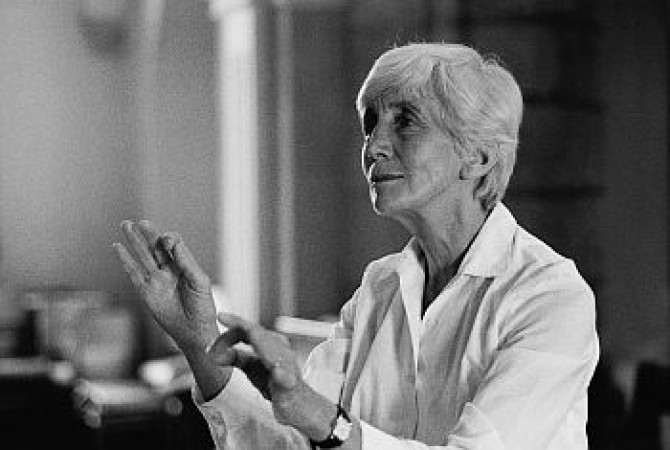
20 April 1929, Baja - 23 January 2017, Budapest
"She is our greatest choir artist; if she can be compared to anyone at all, it must be to the giants of the tradition-creating Bárdos-Vásárhelyi generation", wrote János Breuer in March 2000. György Kroó wrote in connection with a 1980 concert: "It is perhaps Kodály's Pünkösdölő (Pentecostal celebration) that represents most fully the many values with which Mária Katanics's choir serves the cause of Hungarian cultural education".
The girl born in the week when the Pünkösdölő had its original premiere, sang in Ferenc Bálint's choir in Baja, then in the teacher training college in Sister Olga Gajdán's choir of national renown. She studied the piano with Ilona Recske, Sándor Kovács's onetime pupil, for ten years. Coming home from school, she encountered every day the music of Beethoven, Schubert and Schumann, played by her mother. Music – the choirs of the town of Baja, the concerts of notable artists there, the visit by Lajos Bárdos - provided the background to the carefree, happy years of childhood spent with her two older siblings.
Her path led straight to the Music Academy, where between 1948 and 1952 she completed the secondary school singing teacher and choir master course under the direction of Lajos Bárdos, Zoltán Vásárhelyi, Jenő Ádám and Zoltán Horusitzky. She sang in Miklós Forrai's Budapest Choir and on Sundays in the Matthias Church under the baton of Lajos Bárdos. In summer she went round the country collecting folksongs, with László Lajtha as leader. At a Music Academy concert, Béla Bálint, the then headmaster of the Erzsébet Szilágyi Grammar School, heard her splendid choir and invited her to join the school as the successor to the legendary, but by then aged choir-master, Adrienne Sztojanovics. Maria Katanics began teaching at the school in September 1959. In November, following the traditional Erzsébet-day celebrations, which were graced by the presence of Kodály and Bárdos, she founded, with thirty members of the enthusiastic 150-member choir, the Erzsébet Szilágyi Women's Choir. Thirty trips abroad, concerts in virtually every Hungarian town from Sopron to Nyíregyháza, countless radio and television appearances, about twenty-five original premieres and about fifty prizes won at international competitions: these are the dry data about the choir's successes. Huge talent, hard work and boundless love lay behind this achievement. "Mrs Mohay, Mária Katanics is a sensitive and highly talented musician, who has definite and well-founded ideas concerning every work to be performed. This, of course, has left its mark on the choir as well. It has a fine and pure sound…" - wrote András Pernye of the choir when it was barely ten years old. "It is wonderful when a choir reaches technical heights which normally only characterise instrumental ensembles with the purest intonation! At the same time – with the emotional expressiveness of the human voice – it is superior to any instrument. (…) The bright sound of certain harmonies and the dynamic and tonal proportions between the parts give the most wonderful aesthetic pleasure to the listener" - said Kamilló Lendvay in praise of Mária Katanics's work over the decades.
She educated the members of her choir not only in music: by her whole life provided an example for them to be followed. It is no accident that about sixty onetime pupils of "Szilágyi" have become professional musicians, among them Mária Eckhardt, the director of the Liszt Museum, Adrienne Csengery, opera singer and head of the opera singer and choir-master department, and Éva Kollár. Katalin Komlós, head of the music theory department, also sang in the choir for several years.
After twelve years at the Erzsébet Szilágyi Grammar School, Mária Katanics moved to another school: she chose the Marczibányi Square Music General School because besides the pupils of grammar-school age, she wanted to teach younger children as well. During her years at both schools she was also the practice-leading teacher at the Music Academy. She remained active even after retirement, teaching and directing the choir of the Zsámbék Teacher Training College, and, parallel with this, teaching at the Singing and Music Department of the Teacher Training Section of the Loránd Eötvös University of Budapest. She was invited to all parts of the country to give lectures, judge competions and – not least – to conduct. For years she was a regular guest conductor of the Radio Choir and conducted the National Choir at several concerts. She was guest professor in Japan twice, and in the United States eight times. Her two books (Bartók's 27 for single-sex choirs, 1982; A selection from Kodály's choir works, 1986) provide great help for choir masters in Hungary. Her achievements were rewarded by the Liszt and Kodály Prizes and the Minor Cross of the Hungarian Republic. János Breuer was right to call her "the magus of the most profound spirit, who as choir master enthrals the members of her choir and the listeners alike".
Á.G.


